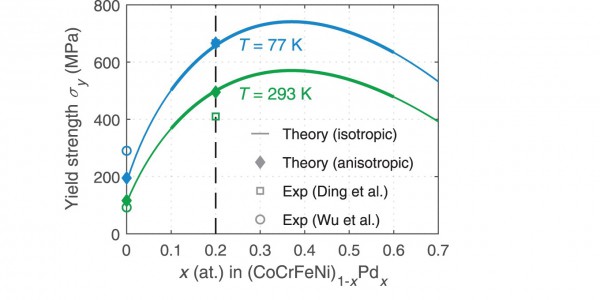Strength of high-entropy alloy CoCrFeNiPd linked to large Pd misfit volume, theory shows
by Carey Sargent, NCCR MARVEL, EPFL
The observation of impressive mechanical properties of a number of high-entropy alloys (HEAs)—multicomponent random alloys that typically have near-equal concentrations of the constituent alloying elements—has driven research into expanding the range of compositions of these new alloys. The Co-Cr-Fe-Mn-Ni family for instance has recently been extended to create CoCrFeNiPd, which is 2.5 times stronger than that of CoCrFeNi. Research recently published in Nature asserted that the increase in strength of CoCrFeNiPd compared with CoCrFeNiMn, a material that has a strength close to that of CoCrFeNi, is due to the non-random concentration variations in the atomic distribution of elements revealed by nanoscale compositional analysis in the CoCrFeNiPd alloy over length scales of 1 nm. Such variations were not observed in either of the lower-strength materials.
In a recently published paper however, Curtin and scientist Binglun Yin show that the measured strength in CoCrFeNiPd can be well predicted using their recent solute strengthening theory for random alloys. That is, while the observation of non-random composition fluctuations in the CoCrFeNiPd HEA is interesting, the high strengthening in the alloy can be understood qualitatively and quantitatively by considering the random alloy. The non-random composition fluctuations are therefore not necessary for achieving high strength. The high strengthening arises because dislocations in the alloy interact strongly with the Pd atoms, due to the large misfit volume of Pd when it is introduced into the CoCrFeNi alloy.

Figure 1: The prediction of initial yield strength of pseudo-binary alloy (CoCrFeNi)1−xPdx as a function of x, at loading strain rate 10−3 s−1 and various temperatures.
Yin and Curtin were further able to argue that the observed local compositional variations, mainly regions with increased Pd content, should not change the strength appreciably as compared to the random CoCrFeNiPd. For instance, they applied the random alloy theory to the pseudo-binary (CoCrFeNi)1-xPdx and predicted that the maximum strengthening versus x is only ~15% higher than the strength at x=0.2. They further considered hypothetical compositions of CoCr2Fe2NiPd4 (higher Pd, Cr, and Fe; lower Co and Ni) and Co2CrFeNi2Pd (lower Pd, Cr, and Fe; higher Co and Ni) roughly consistent with the observed composition variations in the non-random alloy, and predicted strength variations of only +/-10%. These results further supported their contention that the 250% strengthening of CoCrFeNiPd over CoCrFeNi is due mainly to the Pd misfit volume and not due to composition fluctuations.
More generally, the researchers say that their approach of predicting alloy strength using the random alloy model provides a number of advantages: it can be used to predict performance a priori within a set of broadly applicable assumptions. This provides a computational pathway for guiding alloy design, which is essentially because the of the immense composition space of the multicomponent HEAs. For instance, in a 5-component alloy, there are 650,000 compositions differing by at least a few percent; finding the strongest alloy(s) among these 650,000 cannot be done experimentally. And, if the current theory fails for a given system, it can help indicate new mechanisms of strengthening beyond those embedded in the current theory.
References:
Binglun Yin & W. A. Curtin (2020) Origin of high strength in the CoCrFeNiPd high-entropy alloy, Materials Research Letters, 8:6, 209-215, DOI: 10.1080/21663831.2020.1739156
Low-volume newsletters, targeted to the scientific and industrial communities.
Subscribe to our newsletter